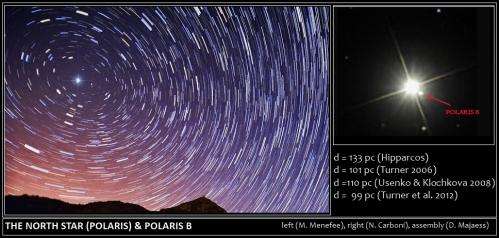Astronomers clash over the distance to the famed North Star

(Phys.org)—The North Star (Polaris) has played an important role in human history, yet knowledge of its fundamental parameters is unsatisfactory. That problem is attributable in large part to uncertainties tied to the star's distance, which have now been resolved in a paper by David Turner and colleagues.
Polaris is the nearest pulsating star designated as a Cepheid variable. Solid knowledge of the distance to Polaris will facilitate efforts to determine the Hubble constant and constrain parameters for the mysterious dark energy. A reliable distance to Polaris would enable further calibration of the famed Cepheid relations, which lie at the heart of establishing the cosmic distance scale.
The ambiguity concerning the distance to Polaris, or rather the stars that constitute the Polaris system (there exist at least two companions), stems from the fact that the Hipparcos satellite measured its distance to be 133 pc (434 light-years), whereas some other studies placed it closer to the Sun. Turner's paper in the Astrophysical Journal Letters advocates a distance of 99 pc (323 light-years).
The new distance established for Polaris by David Turner and collaborators relies on a high-resolution spectral analysis. The discrepancy between the various distance estimates for Polaris translates into a 30% relative uncertainty, which ironically implies that astronomers know the distances to certain galaxies orbiting the Milky Way (i.e., the Magellanic Clouds) to better relative accuracy, despite their being some 500 times more distant than Polaris.
"Polaris presents certain anomalies that have so far defied a straightforward interpretation," noted Turner. He went on to add, "Our high-resolution spectroscopic observations of Polaris may signal the beginning of a new era in understanding the star."
More information: A preprint of the article, which will appear in the Astrophysical Journal Letters, is available here: arxiv.org/abs/1211.6103
Provided by Canadian Astronomical Society

















